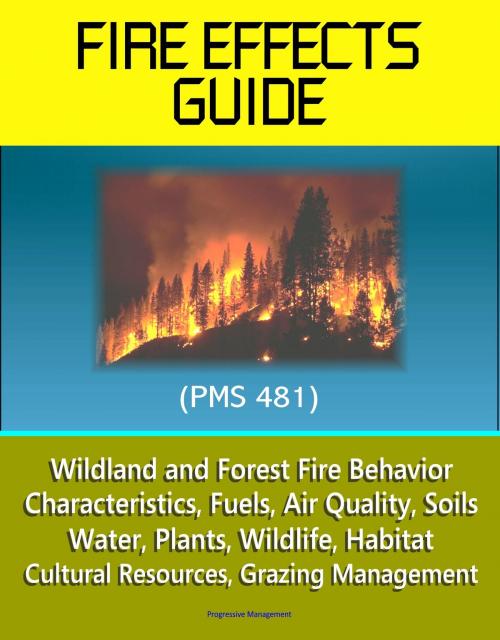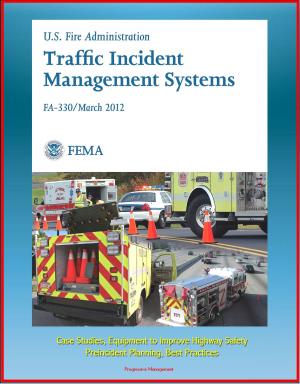Fire Effects Guide (PMS 481) - Wildland and Forest Fire Behavior, Characteristics, Fuels, Air Quality, Soils, Water, Plants, Wildlife, Habitat, Cultural Resources, Grazing Management
Nonfiction, Science & Nature, Technology, Fire Science, Science, Biological Sciences, Environmental Science| Author: | Progressive Management | ISBN: | 9781311861153 |
| Publisher: | Progressive Management | Publication: | August 19, 2014 |
| Imprint: | Smashwords Edition | Language: | English |
| Author: | Progressive Management |
| ISBN: | 9781311861153 |
| Publisher: | Progressive Management |
| Publication: | August 19, 2014 |
| Imprint: | Smashwords Edition |
| Language: | English |
The Federal government manages a variety of ecosystems across the United States, including deserts, grasslands, tundra, shrublands, forestlands, estuaries, and riparian zones. These ecosystems range from arid to humid, warm to cold, and sea level to over 10,000 feet elevation. Fires naturally occur in almost all of these ecosystems, with fire characteristics determined by climate, vegetation, and terrain. The purposes of this Guide are to summarize available information on fire effects principles and processes, provide references for additional information, and provide guidelines for the collection, analysis, and evaluation of wild and prescribed fire effects data. Basic mechanisms of fire effects are described so that the reader will be able to understand and interpret fire effects literature, and evaluate observed results that conflict with those presented in published reports. The goal is to improve fire management by improving our ability to manage fire effects. The Guide was written as an aid for resource managers and fire managers. It can be used for managing and evaluating wildfires; developing and implementing emergency fire rehabilitation plans; planning, monitoring, and evaluating prescribed fires; developing activity plans such as timber management plans, allotment management plans, and threatened and endangered species recovery plans; and providing fire management input for land use plans.
The chapters of this Guide discuss different elements that relate to our management of fire effects and specific responses of different ecosystem components to fire. This Handbook recognizes that separate discussions of fire effects on fuels, soils, watershed, plants, and wildlife are artificial, because fire effects are an integration of the responses of all of these components to fire. Despite the fact that fire effects occur holistically, ecosystem components are discussed individually as a means of organizing the information. Chapters describe basic principles and processes that regulate fire effects, including fire behavior and characteristics, fuels, air quality, soils and watershed, plants, wildlife, and cultural values. Considerations for management of fire effects on these resources, and a discussion of appropriate techniques for monitoring fire effects, are contained in each of these chapters. Monitoring is included in this Handbook because techniques that accurately describe long-term trends in plant community condition, for example, are not adequate to detect significant and sudden changes caused by burning. Because an understanding of prefire and postfire grazing management, data analysis, and documentation and evaluation procedures is critical to sound management and monitoring of fire effects, chapters on each of these topics are also included. Resource management is goal oriented. The first chapter in this Guide is a discussion of goals and objectives and how they fit into planning for the use and management of fire.
Preface * Chapter 1: Development of Objectives * Chapter 2: Fire Behavior and Characteristics * Chapter 3: Fuels * Chapter 4: Air Quality * Chapter 5: Soils, Water, and Watersheds * Chapter 6: Plants * Chapter 7: Terrestrial Wildlife and Habitat * Chapter 8: Cultural Resources * Chapter 9: Prefire and Postfire Grazing Management * Chapter 10: Evaluation * Chapter 11: Data Management * Chapter 12: Computer Software
The Federal government manages a variety of ecosystems across the United States, including deserts, grasslands, tundra, shrublands, forestlands, estuaries, and riparian zones. These ecosystems range from arid to humid, warm to cold, and sea level to over 10,000 feet elevation. Fires naturally occur in almost all of these ecosystems, with fire characteristics determined by climate, vegetation, and terrain. The purposes of this Guide are to summarize available information on fire effects principles and processes, provide references for additional information, and provide guidelines for the collection, analysis, and evaluation of wild and prescribed fire effects data. Basic mechanisms of fire effects are described so that the reader will be able to understand and interpret fire effects literature, and evaluate observed results that conflict with those presented in published reports. The goal is to improve fire management by improving our ability to manage fire effects. The Guide was written as an aid for resource managers and fire managers. It can be used for managing and evaluating wildfires; developing and implementing emergency fire rehabilitation plans; planning, monitoring, and evaluating prescribed fires; developing activity plans such as timber management plans, allotment management plans, and threatened and endangered species recovery plans; and providing fire management input for land use plans.
The chapters of this Guide discuss different elements that relate to our management of fire effects and specific responses of different ecosystem components to fire. This Handbook recognizes that separate discussions of fire effects on fuels, soils, watershed, plants, and wildlife are artificial, because fire effects are an integration of the responses of all of these components to fire. Despite the fact that fire effects occur holistically, ecosystem components are discussed individually as a means of organizing the information. Chapters describe basic principles and processes that regulate fire effects, including fire behavior and characteristics, fuels, air quality, soils and watershed, plants, wildlife, and cultural values. Considerations for management of fire effects on these resources, and a discussion of appropriate techniques for monitoring fire effects, are contained in each of these chapters. Monitoring is included in this Handbook because techniques that accurately describe long-term trends in plant community condition, for example, are not adequate to detect significant and sudden changes caused by burning. Because an understanding of prefire and postfire grazing management, data analysis, and documentation and evaluation procedures is critical to sound management and monitoring of fire effects, chapters on each of these topics are also included. Resource management is goal oriented. The first chapter in this Guide is a discussion of goals and objectives and how they fit into planning for the use and management of fire.
Preface * Chapter 1: Development of Objectives * Chapter 2: Fire Behavior and Characteristics * Chapter 3: Fuels * Chapter 4: Air Quality * Chapter 5: Soils, Water, and Watersheds * Chapter 6: Plants * Chapter 7: Terrestrial Wildlife and Habitat * Chapter 8: Cultural Resources * Chapter 9: Prefire and Postfire Grazing Management * Chapter 10: Evaluation * Chapter 11: Data Management * Chapter 12: Computer Software















